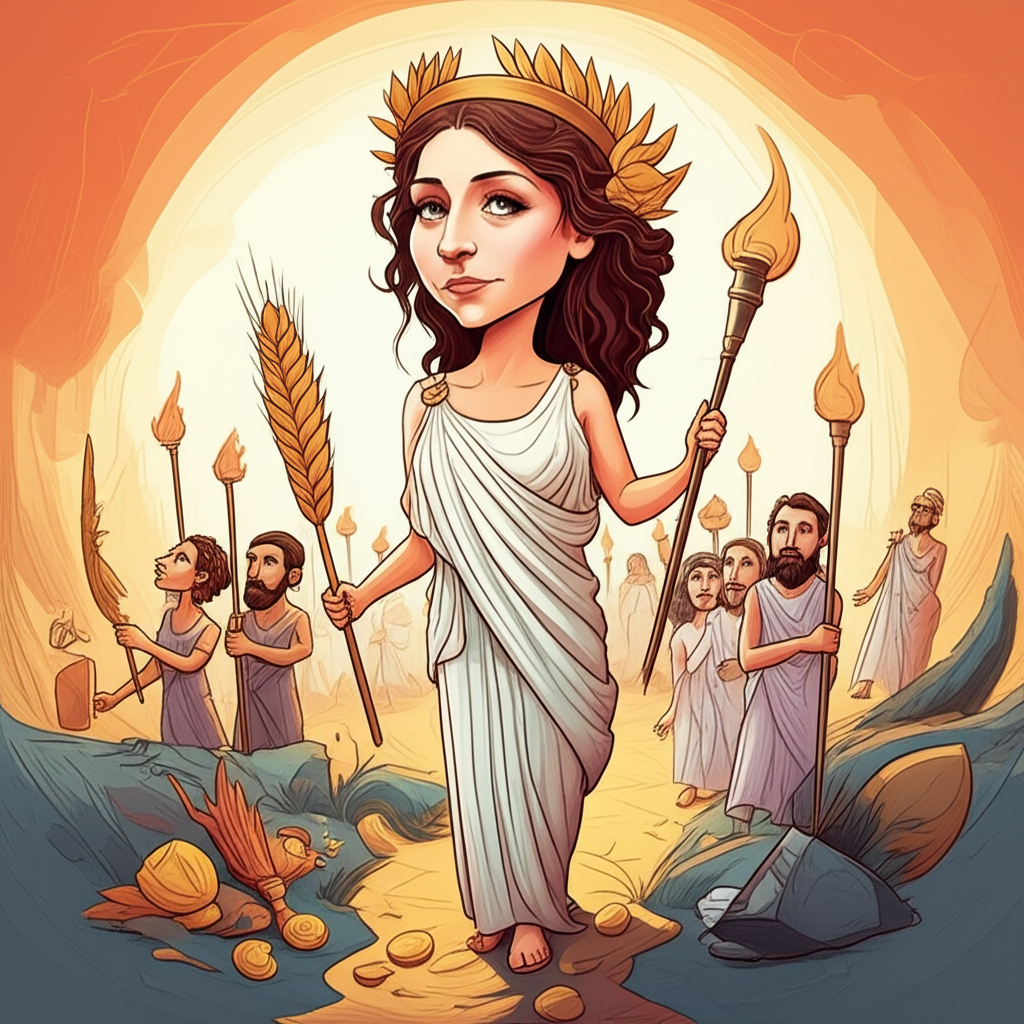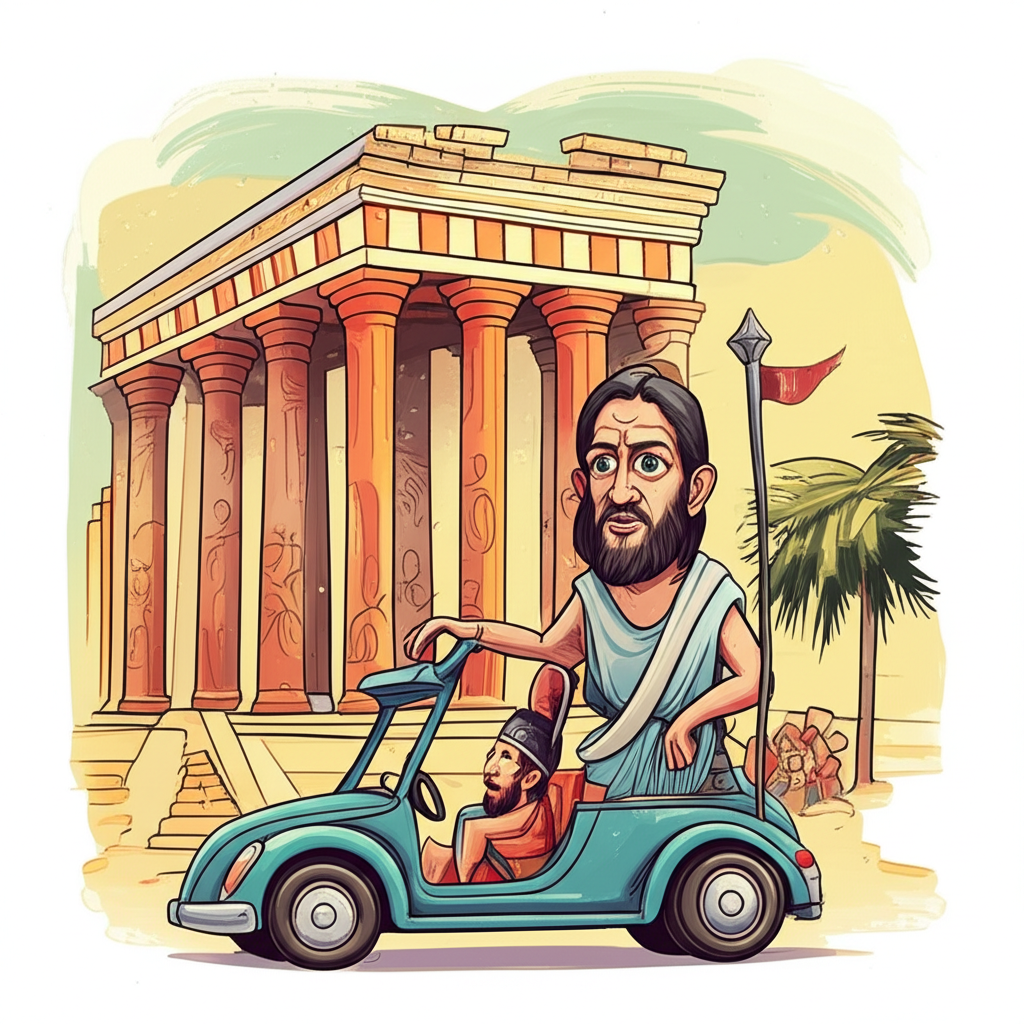
Disclaimer: This article explores a story from ancient mythology for cultural, historical, and educational understanding. It is a work of folklore and is not presented as a factual account or a system of belief to be practiced. The beings and events described are part of a rich storytelling tradition, not a reflection of reality.
Introduction
From the sun-drenched shores and olive-groved hills of ancient Greece comes a vast collection of stories that sought to explain the world. These tales, passed down through generations of poets and orators, were not just entertainment; they were the framework through which people understood the turning of the seasons, the complexities of human emotion, and their place in the cosmos. One of the most significant and secretive traditions born from this mythology was the Eleusinian Mysteries. While this sacred journey is famously centered on the goddesses Demeter and Persephone, its profound impact can be understood through the quiet, steady perspective of another figure: Hestia, the keeper of the sacred flame. This is a retelling of that foundational myth, seen through the eyes of the goddess who represented the unchanging heart of home and civilization.
Origins and Cultural Background
The myth of Demeter and Persephone, which forms the basis of the Eleusinian Mysteries, flourished in a world deeply connected to the land. Ancient Greek society was overwhelmingly agrarian, its survival dictated by the success of the harvest. The cycle of planting in the spring, tending crops in the summer, harvesting in the fall, and enduring the barrenness of winter was the rhythm of life itself. The people of this era viewed their world as a place alive with divine influence. The wind, the sea, the sun, and the soil were not merely natural phenomena; they were expressions of powerful beings whose moods and actions directly impacted mortal existence. A drought was not just a lack of rain; it was the sorrow of a god. A bountiful harvest was not just good fortune; it was a blessing. In this context, a story that explained the very existence of the seasons was not a flight of fancy, but a profound and essential truth about the order of their world.
Character Description: Hestia, The Unmoving Center
In the pantheon of vibrant, often tumultuous Olympian gods, Hestia was a figure of serene constancy. As the firstborn child of the Titans Cronus and Rhea, she held a place of immense honor. She was the goddess of the hearth, the home, the family, and the altar. Symbolically, Hestia was the flame at the center of every household and every city. This flame was never to be extinguished, as it represented the continuity, warmth, and stability of the community.
Unlike her siblings, who were embroiled in conflicts and adventures, Hestia chose a life of peaceful service. She took an oath to remain a virgin goddess, dedicating herself entirely to her role as a guardian of domestic and civic order. She did not have a throne in the grand Olympian court; her place was at the central hearth, the very heart of their world. Her symbolic attributes were not of power or conquest, but of unity, peace, and the sacred duty of providing a safe and stable center around which life could flourish. She was the anchor in a sea of chaos, the quiet warmth that persists through the coldest storms.
Main Story: A Chill at the Heart of the World
According to the ancient story, the world was once a place of eternal spring. Demeter, the goddess of the harvest, walked the earth, and wherever she stepped, life bloomed. Her daughter, Persephone, was the embodiment of this joy, a maiden as bright as the wildflowers she loved to gather.
From her place by the great hearth of Olympus, Hestia felt the perfect balance of the cosmos. The fire before her burned with a steady, golden light, its warmth a reflection of the world’s contentment. But one day, a tremor ran through the foundations of existence. It was not an earthquake, but a sound—a single, piercing scream of terror and loss that tore through the fabric of the world. Persephone was gone, stolen away by Hades, the lord of the Underworld, who had risen from a chasm in the earth to claim her as his bride.
The central hearth on Olympus flickered violently, its flames turning a pale, sickly blue. Hestia, the guardian of that flame, felt the shock as a physical blow. The world’s heart had been wounded.
Demeter’s grief was a force of nature. Forgetting her duties, she roamed the earth in search of her daughter, her sorrow turning the vibrant world barren. Hestia watched from above as the green fields turned brown and the leaves withered on the trees. On earth, mortal families huddled around their own hearths, but the fires gave little comfort. The chill that had seized the world was not one of weather, but of despair, and it seeped through every wall and into every home. Hestia felt the coldness in her own immortal bones, for as the hearths of mortals grew weak, so too did the great flame of Olympus.
Demeter’s journey was long and agonizing. Finally, she learned the truth of her daughter’s abduction. In her rage and sorrow, she withdrew her life-giving power from the earth entirely. The first winter fell upon humanity. The soil froze, and starvation threatened all mortal life.
It was during this time of global winter that Demeter, disguised as an old woman, came to the city of Eleusis. There, she was taken into the home of King Celeus and Queen Metaneira. In this mortal home, tending to a small, warm hearth, Demeter found a flicker of purpose. She cared for the queen’s infant son, and for a brief time, the warmth of a family hearth soothed her cosmic grief. This experience in Eleusis planted a seed.
Seeing the world dying, Zeus, the king of the gods, knew he must act. He sent Hermes, the messenger, to the Underworld to demand Persephone’s return. A compromise was struck. Because Persephone had eaten a few pomegranate seeds—the food of the dead—she was bound to the Underworld for a portion of the year. For the rest of the year, she could return to her mother.
When Persephone emerged from the darkness and into her mother’s arms, Hestia felt the shift instantly. The great hearth of Olympus roared back to life, its golden warmth spreading through the heavens. On earth, the snows melted, the buds returned to the trees, and the fields became green again. Spring had returned.
Demeter, overjoyed but forever changed by her experience, established her Mysteries at Eleusis, the place that had given her shelter. She taught the people the sacred rites that would explain the cycle she had endured: the sorrow of loss (winter), the joy of return (spring), and the promise of life continuing even after a journey through darkness.
Symbolism and Meaning
To the ancient Greeks, this narrative was a powerful explanation for the natural world. The abduction of Persephone and the grief of Demeter provided a dramatic and emotional reason for the existence of the seasons. Winter was not just a cold time; it was the period of Demeter’s annual mourning. Spring was the celebration of her reunion with her daughter.
On a deeper level, the story represented the inescapable cycle of life, death, and rebirth. Persephone’s journey into the Underworld and back was a potent metaphor. The Eleusinian Mysteries, the secret rites Demeter taught, were believed to give initiates a special understanding of this cycle, promising them a more hopeful afterlife and removing the fear of death. For an agricultural people who planted seeds in the dark earth and trusted they would sprout into new life, this symbolism was profoundly resonant. Hestia’s role in this cosmic drama is that of the constant. While the world plunges into the chaos of seasons and emotions, the hearth—the center of home and society—endures. It represents the hope and stability that people cling to during times of hardship, the promise that warmth and community will eventually return.
Modern Perspective
Today, the myth of Demeter and Persephone continues to captivate the human imagination. It is no longer a religious explanation for the seasons but is studied and reinterpreted in literature, art, and psychology. Authors like Madeline Miller and poets like Rita Dove have explored the tale’s deep psychological themes of loss, trauma, and mother-daughter relationships. The popular musical Hadestown and video games like Hades have reimagined these characters for modern audiences, focusing on their human-like emotions and complex motivations. In academic fields, the story is analyzed for its insights into ancient Greek culture, gender roles, and the human need to create meaning in the face of mortality.
Conclusion
The story of the Eleusinian Mysteries, framed by the quiet observation of Hestia, is a testament to the enduring power of storytelling. It is a cultural artifact, a rich and imaginative narrative that ancient people used to make sense of their world. It is a window into their fears, their hopes, and their deep connection to the earth.
As Muslims, we recognize that only Allah is the true Creator and Sustainer, the sole orchestrator of the seasons and the cycles of life and death. The stories of ancient mythology are not matters of faith but are part of the vast and diverse tapestry of human culture. By studying them, we gain a deeper understanding of history, art, and the timeless human quest for meaning. These myths remind us of the power of imagination and the shared heritage of storytelling that connects us all across the ages.





